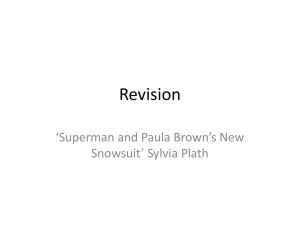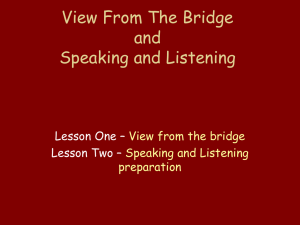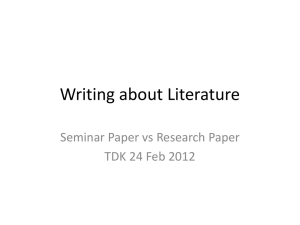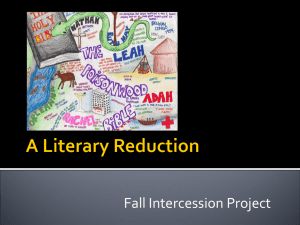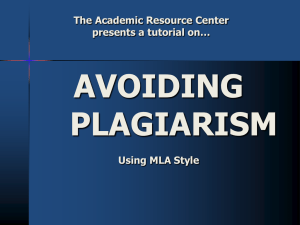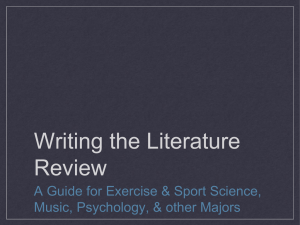references method
advertisement
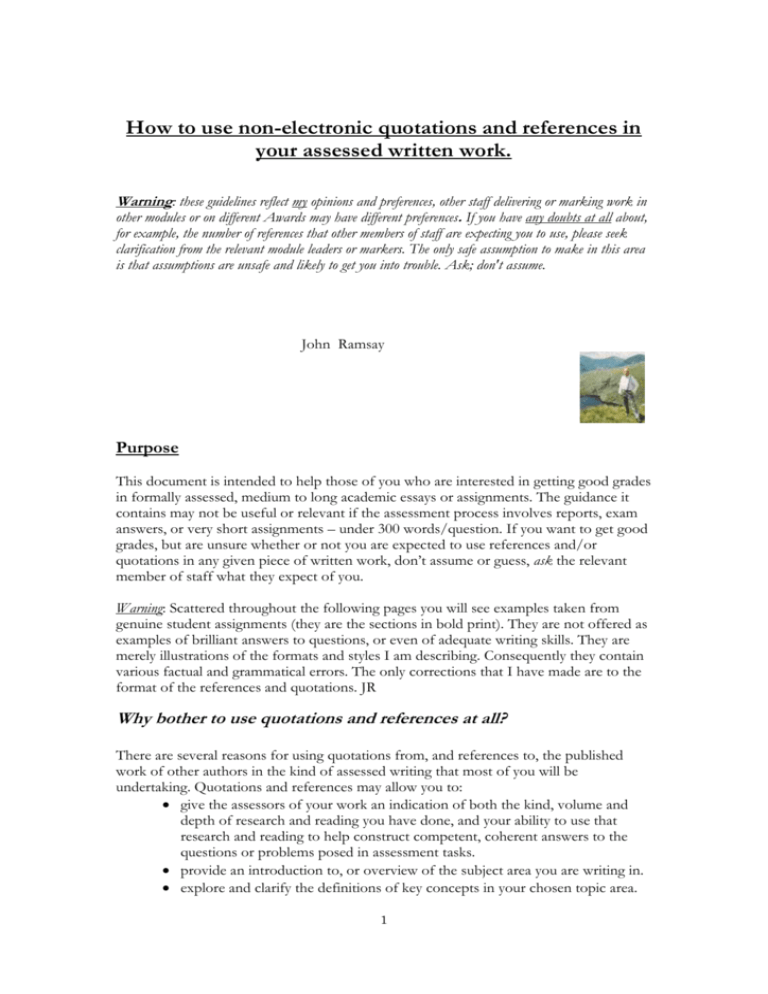
How to use non-electronic quotations and references in your assessed written work. Warning: these guidelines reflect my opinions and preferences, other staff delivering or marking work in other modules or on different Awards may have different preferences. If you have any doubts at all about, for example, the number of references that other members of staff are expecting you to use, please seek clarification from the relevant module leaders or markers. The only safe assumption to make in this area is that assumptions are unsafe and likely to get you into trouble. Ask; don't assume. John Ramsay Purpose This document is intended to help those of you who are interested in getting good grades in formally assessed, medium to long academic essays or assignments. The guidance it contains may not be useful or relevant if the assessment process involves reports, exam answers, or very short assignments – under 300 words/question. If you want to get good grades, but are unsure whether or not you are expected to use references and/or quotations in any given piece of written work, don’t assume or guess, ask the relevant member of staff what they expect of you. Warning: Scattered throughout the following pages you will see examples taken from genuine student assignments (they are the sections in bold print). They are not offered as examples of brilliant answers to questions, or even of adequate writing skills. They are merely illustrations of the formats and styles I am describing. Consequently they contain various factual and grammatical errors. The only corrections that I have made are to the format of the references and quotations. JR Why bother to use quotations and references at all? There are several reasons for using quotations from, and references to, the published work of other authors in the kind of assessed writing that most of you will be undertaking. Quotations and references may allow you to: give the assessors of your work an indication of both the kind, volume and depth of research and reading you have done, and your ability to use that research and reading to help construct competent, coherent answers to the questions or problems posed in assessment tasks. provide an introduction to, or overview of the subject area you are writing in. explore and clarify the definitions of key concepts in your chosen topic area. 1 clarify points of view - particularly when different authorities in a field have conflicting opinions concerning a problem or situation. cite evidence that backs up and thus lends authoritative credibility to statements you make, or arguments you are developing. save words by referring to authors or texts that represent or stand for collections of ideas or bodies of work. In general, the more closely your behaviour and work matches that of professional academics, the better your grades are likely to be. Thus, in general terms, your writing style and format should resemble that found in academic journals. Clearly, you cannot precisely match the behaviour of academics because you have neither the time nor expertise. However, you are expected to do the best you can, and that includes employing an approved method of using quotations and referring to your sources. All academic disciplines are necessarily built upon the collected work of many scholars. Student essays and assignments must also rest upon those same foundations, showing how the ideas of different authors are related, in harmony or conflict. Making use of that accumulation of academic effort, (within reason and the restrictions imposed by the University’s plagiarism regulations) and referring correctly to the sources employed in a piece of writing, is a normal, expected characteristic of high quality academic work. If you want to get good grades, you would be advised to follow the format recommended in this document. What format should I use when referring to somebody else’s work? There are a number of different reasons for referring to the work of others without actually quoting their words directly (see below). Whatever the reason, I recommend that if you are referring to a specific, detailed point or narrow argument employed by an author then you should cite the author's surname, the year of the publication of the work you are referring to and the page number where the point or argument appears thus: Companies in the South Korean electronic industry in the 1990s were merely protecting themselves (Clark, 1979, p. 32). As a result they became leaders in their area of the industry. NB this is not a quotation, these words are simply taken from the text of a student answer. The reference is in the brackets and this student is referring to material on page 32 of a book that was published in 1979 and written by an author whose surname is ‘Clark’. The full details of the text referred to should appear at the end of your essay or assignment in a reference list, the relevant entry for the reference above should look like this: References Clark, R., The Japanese company, Yale U.P., 1979 The author’s name is R. Clark, the book’s title was The Japanese Company, and it was published by Yale University Press in 1979. NB That is how you deal with the details of a textbook, other kinds of publication, such as papers from academic journal, newspaper 2 articles and so on, have slightly different layouts (see the Appendix at the end of this document). If, instead of referring to a detailed topic or narrow argument, you want to refer to a very broad topic area or whole set of arguments used by an author then it is conventional to omit the page number, thus: The practice of erecting barriers in the form of import controls is merely one of a range of measures employed by East Asian countries in the early stages of their development (Francis, 1999) to protect their infant industries from global competition from established Western companies. The reference list format is unchanged. What format should I use if I want to quote words directly from the work of somebody else? Here is a short extract from a student assignment in which some words are quoted directly from the work of another author. The quotation is indented from the left hand margin to distinguish it from the student’s own words. If you follow this style there is no need to use inverted commas or italics or any other method of identifying the quotation: Korea’s remarkable growth rate in the 1970s proved unsustainable as the costs of financing a growing foreign debt became increasingly onerous: By the end of 1972, Korea’s foreign debt has risen to a record 9% of GDP. (Park, 1986, p. 1023) However, by the beginning of the 1980s, the debt had been brought largely under control. As you have probably guessed from the information inside the brackets, the quotation was taken by the student from page 1023 of (in this case) a paper in an academic journal that was published in 1986 and written by an author whose second name was ‘Park’. The relevant entry inn the Reference list at the end of the assignment should look like this: References Park, Y., ‘Foreign Debt, Balance of Payments, and Growth prospects: The Case of the Republic of Korea, 1965-88’, World Development, 14, 8, (1986): 1019-58 The author’s name is Y. Park, the paper’s title was ‘Foreign Debt, Balance of Payments, and Growth prospects: The Case of the Republic of Korea, 1965-88’. The paper appeared on pages 1019 to 1058 in the 8th part of the 14th volume of a journal called World Development that was published in 1986. You may also have noticed that the title of the publication that the article appeared in, rather than the title of the article itself, has been underlined. What is the correct format if a quotation includes a reference to the work of another author? 3 Occasionally you may find that a particularly effective quotation that you would like to use includes a reference to another, different author, like this: There have been a variety of different theories developed over the years to try to explain negotiator behaviour with respect to their psychological motivations (see for example Fells, 1998, pp. 45-56). Bazerman, 1992, p. 253 If this happens you should give the full references for both authors in your reference list. How many references and quotations should I use? This is one of the most perplexing questions in this area of academic conventions. It will help if you can keep the reasons for using quotations and references in mind when deciding how many to use, and how best to use them. You should also be aware that on modules where the staff have indicated that you should be making explicit use of the published literature in the area, a complete absence of references and quotations will normally suggest to your assessors (even if this is not an accurate impression!) that you have done very little reading in preparing your work. Students who attain high grades tend to have done a relatively large amount of preparatory reading before undertaking assessment tasks. There is no easy answer to the question of precisely how many quotations and references you should use. The answer depends upon a number of factors such as: the nature of the module/academic subject the number of students enrolled on the module combined with the variety and volume of sources available from staff and the library the nature of the writing task and the style of writing the assessors are looking for, and so on. On some full-time undergraduate modules, for example, part of the assessment process involves written assignments requiring students to construct coherent arguments, using evidence from published sources in answer to questions. Although there may be quite a large number of students enrolled on the module, the library may contain quite a wide variety of texts on the subject matter along with, possibly, an extensive collection of offprints of relevant articles. Consequently, although it may well be possible to produce pass-grade assignments on such modules with only a smattering of references to, say, the main recommended text, staff would normally expect to see reference to and quotations from, several different sources in high-scoring assignments. References The number of references/paragraph (what one might call the ‘reference-density’) you are likely to use in an assignment will tend to vary depending upon which part of the assignment you are working on. Opening of an assignment/essay If your assignment or essay has a paragraph near the beginning that acts as a kind of miniature literature survey, in which you refer to the main theories or arguments in the 4 published literature surrounding the topic the assignment deals with, then your assessors may well expect you to have a high reference-density in that paragraph. This is especially true if the assignment deals with a controversial subject where a variety of valid opinions exist. However, Even in such an opening paragraph it is possible to use too many references, viz.: Following WWII, the Ministry of Trade and Industry (MITI), who were responsible for creating and implementing specific policies (Ito, 1992, p. 198) pursued goals of growth maximisation (Boltho, 1985, p. 188). Between 1950 and 1983 the economy grew at an average rate of 10% per annum (Ito, 1993, p. 43), but the mere presence of government aims and policies does not facilitate (sic) causation (Sakoh, 1984, p. 528). The gap between supporters and critics of Japanese industrial policy is large (Ito, 1993, p. 204). Some conclude that Japan’s policy played a very important role in shaping the country’s development (Boltho, 1985, p. 188) whereas others claim that ‘Japan’s success has been in spite of, rather than because of government tinkering.’ (Sakoh, 1984, p. 542). In this extract from a genuine assignment, although the paragraph is indeed acting as a miniature literature survey, the student writer has referenced every single statement. More is not always better in this game. Some of the references in this extract are also redundant because they merely support uncontroversial facts. 5 If the superfluous references are removed you are left with the kind of reference density that might reasonably be expected in an assignment set by a member of staff who wants you to make good use of the available literature in the subject area, dealing with a controversial topic on a module well supplied with relevant texts, thus: Following WWII, the Ministry of Trade and Industry (MITI), who were responsible for creating and implementing specific policies (Ito, 1992, p. 198) pursued goals of growth maximisation. Between 1950 and 1983 the economy grew at an average rate of 10% per annum, but the mere presence of government aims and policies does not facilitate (sic) causation. The gap between supporters and critics of Japanese industrial policy is large. Some conclude that Japan’s policy played a very important role in shaping the country’s development (Boltho, 1985, p. 188) whereas others claim that ‘Japan’s success has been in spite of, rather than because of government tinkering.’ (Sakoh, 1984, p. 542). Main Body of an assignment/essay After the concentration in the opening paragraph, the reference-density will normally decline quite sharply in the main body of the work. With paragraphs of a normal length, as in the following example, many markers expect to see somewhere between one reference every two paragraphs and two references/paragraph. These will be used in the text for a variety of reasons that are explored in some depth in a later section of this document. This next student extract illustrates a ‘normal’ reference-density in the main body of an assignment or essay: There are features that illustrate how the keiretsu protect themselves from takeovers. Firstly, horizontal keiretsu, these are groups of very large companies with common ties to a powerful bank, united by cross-shareholdings and intra-group trading relations (Miyashita & Russell, 1994 p. 46) This structure is mainly seen in distribution. Through this type of structure companies have on going finance to enable their company to grow. Evidence is seen through the keiretsu revolving around a financial core, which includes a major bank. This can result in one company being the single producer, but this does not mean that they are trying to form a monopoly or use monopoly power to achieve market share. These companies are merely protecting themselves (Cutts, 1992, p. 32). As a result they are becoming leaders in their area of industry. Secondly, the structure of vertical keiretsu. This is made up of one very large company and hundreds of small companies subservient to it. This type of structure also enables the keiretsu to protect themselves, especially against domestic and foreign competition. This is apparent through this type of structure. They share ideas and they integrate operations...they also shared design and development costs for parts of their new models (Hideto, 1983, p. 123). This shows how the structure has enabled companies to protect their companies by having resources from their fellow members. This structure also offers protection by infusing capital and personnel or businesses that are suffering. This kind of density is not, I hasten to add, appropriate if you are using those absurdly short paragraphs containing only 20-30 words that have started to appear in some students’ work. If you have adopted this odd, truncated style I am unable to advise you on how many quotations or references you should be using. However, I can recommend that you ask yourself why you are using a paragraphing style that makes your work look like it has been written by someone who is only semi-literate. Very short paragraphs read 6 like a list, and prevent you from developing a flow of reasoning and arguments. In subjects assessed by written essays or assignment, your markers will be looking for evidence of an ability to construct coherent, logical arguments, not shopping lists of facts. Conclusion of an assignment/essay When you get to the conclusion of your work, and turn back to summarise the way in which you have answered the question posed, or solved the problem stated in the assignment or essay’s title, you may decide to increase the reference-density and make several references to the key texts in the subject area that support your conclusion. This particular practice is not mandatory, but it is not at all uncommon. Quotations Where can they be used? Quotations can be employed in much the same ways, and many of the same locations as references. They are most commonly found in introductions, conclusions, in support of contentious arguments and around the definitions of contentious or key concepts and terms. Here are some illustrative examples of these various usages. In introductions Some academics like to start their whole piece of work off with what they regard as a particularly apposite, or provocative quotation. Viz.: [The ’one-shot’ case-study] design is an observation only of what exists at the time of the study, as such, it has no control over extrinsic and intrinsic factors. In addition, it does not allow for manipulation of the independent variable or for before-after or control-group-experimental-group comparison. Nachmias & Nachmias, 1976, p. 42 Criticisms of this kind may have encouraged the abandonment of the case-study approach to empirical research in some academic fields. One authority (Mitchell, 1983, p. 187) observes that the approach seems to have disappeared, for example, in Sociology in the early 1950s when it was replaced by the familiar jargon of variable analysis, sampling techniques et al. This can be a rather risky business. If your assessors feel that the quotation you have chosen is actually rather weak and irrelevant then this particular use of a quotation can be more of a liability than an asset. Oh, and another thing. I would point out that the quotation in the last example is actually quite a bit too long for the kind of tightly length limited written work you will normally be tackling. Unless you are working on a very long dissertation or some such, I would stick to quotations that are no more than two or three lines long. To support contentious or key points in your argument 7 In the following example the student uses a quotation from a relevant text in the area to support the somewhat contentious idea that an economic crisis can be hard to define: This essay will examine the economic crisis faced by Japan in the late 1990s and the reasons for its occurrence. An economic crisis is a gradual process where weaknesses show and spread to effect (sic) more of the economy. A crisis can be very hard to define because an economy can be: Productive but not fruitful, failing to fulfil many of the intrinsic needs of the population. (Woronoff, 1996, p. 125)’ In definitions You may find quotations a convenient method of simultaneously showing that you have read around a subject and offering an authoritative definition of a contentious concept. Thus: The diversity of approaches to the subject of power adopted in other disciplines has created a correspondingly large number of different definitions of the concept ranging from Weber’s venerable: In general, we understand by 'power' the chance of a man or a number of men to realize their own will in a social action even against the resistance of others who are participating in the action. (Weber, 1968, p. 926) through Russell’s: Power is the capacity of some persons to produce intended and foreseen effects on others. (Russell, 1938, p. 25) to Emerson’s : The power of actor A over actor B is the amount of resistance on the part of B which can be potentially overcome by A. (Emerson, 1962, p. 32) Note, it is conventional to provide formal definitions like this only for the main topic being covered in your essay or assignment, or for concepts whose definition is (as in the example above) a matter of some controversy in the academic field you are working in. It is not appropriate to define all of the concepts you are writing about! Nor is it usually necessary to use three quotations as in the example above. One will normally suffice for any given concept In conclusions: Sometimes you may be extremely lucky and come across a sentence or two in a textbook or article that perfectly summarises the main thrust of the argument you have constructed. In those circumstances it is possible to use a quotation in your conclusion. In the following example, the student was tackling this question: ‘The most important factor in explaining Japan’s Twentieth Century international trading success has been the willingness of other countries to buy Japanese exports.’ Discuss the validity of this statement and used the following quote in their conclusion: 8 ‘...the export growth of cotton textiles and other labour-intensive light manufactures, which accounted for a major part of Japanese exports at least until World War II did not benefit from favourable foreign demand.... (Shionoya & Yamazawa, 1972, p. 5) This was directly pertinent to the question they were trying to answer, and helped them conclude their answer elegantly en route to getting an overall mark of 75%. Once again, you are not expected to copy this practice in every piece of written work you do. How many quotes should I use, and how long should they be? All of the examples given above prompt the difficult question of how many quotations you should use in a given piece of work. As with references, there is no easy answer to that question. Staff are not interested in seeing assignments, essays and seminar papers consisting of little more than whole paragraphs taken straight out of text-books with a handful of connecting words written by you. The following extract from a genuine student assignment illustrates this particular, undesirable, practice: Firstly, a general definition/view about the perception of life in a Japanese firm. R. Taggart Murphy (Murphy, 1993, p. 134) states that: Japanese intellectuals grappling with the question of what the Japanese corporation is” answer by “typically settling on one or other variant of employee sovereignty, the idea that the ultimate risk takers in a Japanese corporation, the real owners, are not the shareholders but the people who work there. He then goes onto (sic) use this as a possible reasons for a different perception of task/job of a Japanese manager, stating: .....that if the working people in a Japanese corporation are both its ultimate risk takers and its ultimate beneficiaries - it helps explain many elements of Japanese corporate behaviour. If a Japanese manager, for example, sees it as his task to ensure worker’s salaries twenty years off, he will take a different approach to investment and marketing decisions from that followed by an American (or in this case a Briton) edgy bout quarterly earnings. Leading directly on from the above statement. The key distinguishing feature between Japanese and UK firms is their management, and it is from this that most of the differences (at least in part) stem. Some authors contrast the two different concepts: It is apparent....etc. etc. This student’s work, as you can see, is little more than a series of long quotations joined by a couple of linking sentences. The whole of the assignment followed this style and only the linking sentences were the student’s own work. Since the skill of finding and copying pertinent quotations is, of itself not particularly highly valued by markers, this student failed to answer the question satisfactorily. On a ‘normal’ page of printed text containing something like 450 words most markers would not be surprised to see one or possibly two quotations. They would also regard a flurry of two or three, brief, quotations around an area in the work where particularly contentious concepts or arguments were being discussed as acceptable, and would not 9 necessarily be shocked to find a quotation in an introduction or a conclusion. You can work it out for yourself, that averages something like one quotation every 400 words or thereabouts. Remember, however, this is not a hard and fast rule, merely a rough indication of what your markers would, probably regard as unexceptional. I am sorry that I can’t be more specific than that, but the use of references and quotations is something of an art (or perhaps a craft would be more accurate) rather than a science. There is a large element of personal preference and prejudice built into staff perceptions of essay and assignment layouts. To repeat, if you are at all unsure what your own assessors prefer, you should always make certain by asking them what they want from you. If they seem reluctant to give you an answer, you might try giving them a loan of this document, and asking if they are happy with the recommendations it contains. How will I cope with all of the extra work? Some of you may regard what has gone before as totally alarming. After all, I seem to be suggesting that a 5-6 page 2500 word assignment should contain about 12 references and 7 quotations. That must mean that you are expected to read almost 20 books and/or articles for every 2500 word essay. It’s outrageous! Its unimaginable! It’s plain daft! Yes of course it is. We don’t expect you to read as much as that, although (make no mistake) we would love it if you did. In the first place it is normal practice to make multiple references to different parts of the same text. No one will bat an eyelid if 8 references in an essay refer to only three books. (Warning: If, however, you use several quotations from one book or refer in total to only two titles, that will generate a very poor impression). Moreover, as I am sure you are all well aware, in order to construct high quality essays it is not normally necessary to read all of the relevant literature in its entirety. However, you would be well advised to read the relevant sections of several text-books and/or articles when preparing a piece of written work. It is important that you keep your eye on the reason for adopting these conventions for the use of references and quotations. There is, as I pointed out earlier, something of a game about the whole process; but it is more than that. Anybody can wander over to the library and collect half a dozen apparently relevant book titles, and extract a few vaguely relevant sections out of text-books. Staff will not be impressed by that kind of behaviour. They will, however, reward students who demonstrate the ability to apply knowledge, ideas, opinions and facts gained from reading, thinking, discussion and attendance at lectures and seminars to the construction of logical, credible, coherent answers to questions posed in essay, seminar and assignment titles. The real skill lies in using judiciously selected quotations and references in an appropriate and academically approved way to support the construction of your own arguments. This skill is extremely difficult to fake, but easy to identify. Will I be caught if I cheat? Don’t forget that lecturers are extremely likely to spot-check a few of your references to see if you are just making them up. What’s more, they are also bound to be familiar with the recommended texts on modules and are thus likely to be able to spot unattributed ‘extracts’. So the short answer to the question above is - ‘Yes’. 10 What about a ‘Bibliography’? If you have a look in the back of academic textbooks and papers in academic journals you will find a whole range of different methods of listing the work of other authors bibliographies, indexes of authors, reference lists, select bibliographies, further readings and so on. Some of these lists mention texts and articles referred to in the textbook or paper, some do not. The reason why professional academics use such lists is clear. Bibliographies, for example, allow the author to provide a map of the academic foundation upon which their work is built and supply later scholars with a detailed list of related source material so that they can explore the same literature if they so desire. The authors frequently make no more than a fleeting reference in their own work to the content of any of the texts listed in the bibliography. This particular approach is largely driven by the needs and conventions of professional academics and is entirely irrelevant to your needs. It is very unlikely that the staff who mark your assignments or essays will want to ‘explore the same literature’ as you. It is likely that they have already been here, and done that. Hence my strong recommendation that, unless your assessors tell you differently, you should stick to reference lists containing the details of all the texts you refer to in your work and forget about bibliographies altogether. Remember, in general, if you use only a Bibliography and make no reference to the content of any of the titles within your written work, or use any quotations from those titles, then this is likely to count against you. Your assessors will tend to regard bibliographies of that type as no more than a list of the titles of books you found in the University Library, but have not read! Using that type of bibliography is like waving a large flag in front of your markers with the words: ‘I couldn’t be bothered to do the job properly. I’ve no real idea what I’m doing. Do your worst, I don't care.’ plastered all over it. So consider yourselves warned. NB some American web-sites that deal with referencing techniques may use the words ‘reference list ‘ and ‘bibliography’ interchangeably. Bear in mind that American is a foreign language…… 11 Appendix 1 How to format Reference lists The MLA format To a certain extent the choice of reference or citation list format is arbitrary. If professional academics are writing for a specific publication, then the choice is driven by that publication’s preferences. If students are writing for assessment purposes on a specific University Award, then the choice of format is determined by that Award’s preferences (if stated). If you have been given no explicit instructions on which format to use, then I recommend you to use the format shown in this document. The following examples of different types of items in a reference list employ the format favoured by an organisation called the Modern Languages Association of America (MLA). In the MLA citation system, the relevant publication details (who, what, where, who published, when) of whatever source your are citing appear in the reference list in the following order and with the following punctuation: Last name of author, first name. Book/article title. Place of publication: publisher, date. The MLA system can deal with any kind of source. If the source you are using and need to refer to is not on the list below, then I suggest you refer to the MLA handbook in the library or access one of the web-sites listed at the end of this document. Here are the formats for some sample sources: A book Bhaskar, R., A Realist Theory of Science, London: The Harvester Press, 1978. A book with more than one author Bailey, D., Harte, G. & Sugden, R., Transnationals and Governments, London: Routledge, 1994. An article or essay in an anthology, or chapter in an edited book Gould, S., “Counters and Cable Cars”, The Best American Essays: College edition, Ed. Miller, R. Boston: Houghton, 1995. 270-282. ( “Counters and Cable Cars” is the title of the chapter. The ‘Ed.’ indicates that R. Miller is the editor of the book that Gould’s chapter appears in. If there is more than one editor use ‘Eds.’ before listing their names. The ‘270-282’ specifies the pages of Gould’s chapter within Miller’s book.) Articles in Journals where each issue is page numbered separately 12 Asanuma, B., “Manufacturer-Supplier Relationships in Japan and the Concept of Relation-Specific Skill”, Journal of The Japanese and International Economies, 3, 1, (1980): 1-30. (The ‘3,1, (1980): 1-30’ indicates that it is volume number three, issue number 1, 1980, pages 1 to 10) Articles in Journals where entire volumes made up of several different issues are page numbered continuously Lijphart, A., “Comparative politics and the comparative method.”, American Political Science Review, 65, (1971): 682-693. (NB Because the publication has continuous pagination, there is no need to cite the issue number of the journal. The ‘65’ refers to the volume number. If each issue is numbered separately, the issue number is required – see last example.) Newspaper article Lehtinen, U., “Does Partnership really exist among Finnish manufacturers”, Guardian, 10 May 1996: 27. An Interview McGloughlin, John, personal interview, 27 July 1997. Your Reference List Once you have correctly recorded the details of the texts to which you have referred in your work, you should list them, sorted alphabetically by the authors’ surnames, like this: References Asanuma, B., “Manufacturer-Supplier Relationships in Japan and the Concept of Relation-Specific Skill”, Journal of The Japanese and International Economies, 3, 1, (1980): 1-30. Bailey, D., Harte, G. & Sugden, R., Transnationals and Governments, London: Routledge, 1994. Bhaskar, R., A Realist Theory of Science, London: The Harvester Press, 1978. Gould, S., “Counters and Cable Cars”, The Best American Essays: College edition, Ed. Miller, R. Boston: Houghton, 1995. 270-282. Lehtinen, U., “Does Partnership really exist among Finnish manufacturers”, Guardian, 10 May 1996: 27. 13 Lijphart, A., “Comparative politics and the comparative method.”, American Political Science Review, 65, (1971): 682-693. McGloughlin, John, personal interview, 27 July 1997. Why was the MLA format chosen? My reasons for choosing the MLA format are straightforward. Firstly there is more than one book in the reference section of the University Library providing details of the format, viz.: Achtert, W. & Gibaldi, J., The MLA Style Manual, New York, The Modern Language Association of America, 1985. Achtert, W. & Gibaldi, J., MLA Handbook for writers of Research Papers, New York, The Modern Language Association of America, 1988. Secondly, if you are unable to get access to those books, you can obtain further details at a large number of web-sites including the following: http://www.hcc.hawaii.edu/education/hcc/library/mlahcc.html or http://research.umbc.edu/~romary/info18.htm or http://www.english.uiuc.edu/cws/wworkshop/ (NB If you are reading this in hard-copy form, you can find live (at the time of writing!) links to these three sites on John Ramsay’s personal Web-site on the University computer network) Are there other formats and styles in use? You may well have noticed in your own reading that a variety of different formats is used in academic publications when inserting quotations and describing references. This is extremely confusing. The truth of the matter is that there is no one ‘correct’ format. Different authors favour different formats; different publishers favour different formats; different Universities favour different formats, and, astounding as it may seem, different schools within Universities and different staff within those schools may also favour different formats. Good luck! John Ramsay Last amended 1.11.02 14
